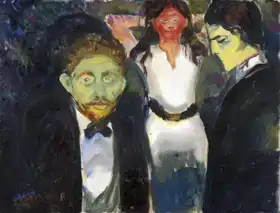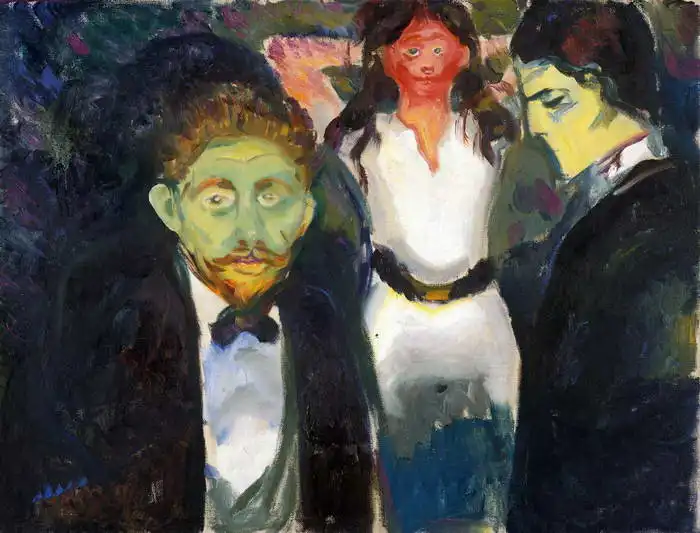About this finishing
Print. The image is printed on the top quality 10-ink HP Z9PS printer on HP matte 270 g / m2 paper. You can choose any size to an accuracy of 1 cm. A margin of 5 cm around the image is added to the size of the motif.


You can find a detailed description about our finishings
here.
Jealousy
The painting depicts a trio of figures in an expressionist style. In the foreground are two men dressed in evening tuxedos, both with intensely expressed faces. On the left is a man with pinkish skin and prominent green facial features, while on the right is a man with bluish-black skin. Between them stands a woman in white clothing with red hair whose face is simplified and bright red. The painting makes use of strong colours and bold brushstrokes.
This description was created by artificial intelligence, please be indulgent.
Prevailing color of this fine art print is dark and its shape is landscape. This image is printed on demand - you can choose material, size and finishing.
Edvard Munch (1863 - 1944) Norwegian painter, graphic designer and influential representative of modern art. He grew out of the spiritual atmosphere of Art Nouveau and his paintings have some characteristics of this style. He studied at the drawing school in Oslo, where he was influenced by naturalism, French
Impressionists,
Postimpressionists, (particularly
Gauguin and
Seurat). His work tends towards
impressionism and
symbolism and became the basis for
expressionism. Through the Berlin exhibition in 1892, he significantly influenced the expressionist group Die Brücke and contributed to the creation of the Berlin Secession. In the Czech Republic, he became known after the exhibition in 1905, which inspired the art group Osma. Among his most famous paintings are, in particular,
The Scream and
Madonna. His paintings are characterized by the simplification of forms and attention to detail. Munch places emphasis on capturing mental states and emotions. Initially, his work lacked a warm reception as the images were labelled as violent, strange and distant to the general audience. After breaking up with lover Tully Larsen in 1906, his neurosis and depression deepened. The last years of his life were spent in the Norwegian countryside, and after the occupation of Norway by the Germans, he lived in fear in his house with his entire collection of paintings. His paintings significantly influenced
expressionism and became representative of this style.


